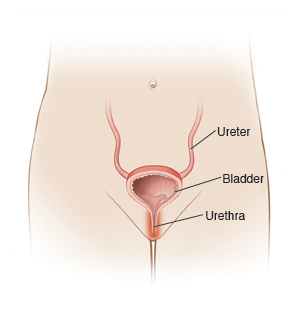The urethra is the channel that passes urine from the bladder. In a girl, the opening of the urethra is above the vagina. In a boy, it's at the tip of the penis. Dysuria is having pain or a burning feeling in the urethra when peeing. Your child may get medicine to help ease pain.
Dysuria can be caused by anything that irritates or inflames the urethra. Examples include:
-
Chemical irritation. This is the most common cause of dysuria in young children. Soaps, bubble baths, or skin lotions can get inside the urethra. Symptoms will get better in 1 to 3 days after the last exposure.
-
Certain foods. Caffeine is the most common. High-potassium and hot, spicy foods can also cause irritation.
-
Bladder infection. A urine test can show this. The health care provider will treat a bacterial bladder infection with antibiotics. Make sure your child takes all of the medicine. They need to take it even when they start feeling better. Symptoms of a UTI usually go away within 24 to 72 hours of starting treatment. Children can also get a viral infection of the bladder. This will get better with time. You don't need antibiotics for a viral infection.
-
Inflammation in the outer vaginal area (rash or vaginal infection). Your child may be given a cream for this.
-
Vaginal infection. This may cause vaginal discharge and dysuria. A culture can diagnose it. Antibiotics may be needed to treat the infection.
-
Labial adhesions. These are a common cause of dysuria in young girls. Parts of the labia are attached together. A small tear can cause pain. The tear will get better on its own. But an estrogen cream can be used to help treat the adhesions.
-
Minor injury. These may result from from activities or self-exploration.
-
Medicines. Review all your child's medicines with your provider.
-
Bladder catheter. Having one for a long time can cause dysuria.
Other causes include dehydration and structural abnormalities of the urinary system.
In rare cases, dysuria is a result of genital injury from sexual abuse. If you have concerns about possible sexual abuse, contact your child's provider right away. Or call the National Child Abuse Hotline at 800-4-A-CHILD (800-422-4453) to get help.
How is dysuria diagnosed?
Your provider will ask about your child's medical history and do a physical exam. Your child may have test, including:
-
Urinalysis. The urine is checked for bacteria and other signs of infection. The urine is sent to a lab for a culture. This shows what kind of bacteria is in the urine. It can take 1 to 3 days to get the results back. The provider may think your child has a urinary tract infection (UTI). In that case they will likely start treatment before the lab results come back.
-
Ultrasonography. This can show if a child's urinary system did not form correctly before birth.
Home care
These tips will help you care for your child at home:
-
Wash the genitals gently with a washcloth and mild soapy water. Make sure soap doesn't get inside the urethra. Dry the area well.
-
If you think bubble bath soap caused the reaction, stop using bubble baths.
-
Use over-the-counter diaper creams to help with irritation in the genital area.
-
Change soiled diapers right away. Keep the genital region clean and dry.
-
Encourage your child to drink water. Have them stay away from foods and drinks that can cause bladder infections.
-
Make sure your child wipes from front to back after using the toilet. Wipe your baby from front to back during diaper changes.
-
Have your child wear loose-fitting underpants and clothing.
-
Regular urination and regular bowel movements may help reduce the risk of UTIs.
-
Soaking in warm water without soap for about 10 minutes can help ease pain. Repeat as needed.
Follow-up care
Follow up with your child's provider, or as advised. If the provider took a culture specimen, call for the result as advised.
When to contact your child's doctor
Contact your child's provider right away if:
-
Your child's symptoms don't go away after 3 days, or new symptoms appear.
-
Your child has a fever of 101°F (38.3°C) or higher, or as advised by the provider.
-
Your child can't pee due to pain.
-
You see increased redness or rash in the genital area.
-
There's discharge or bloody drainage from the penis or vagina.


